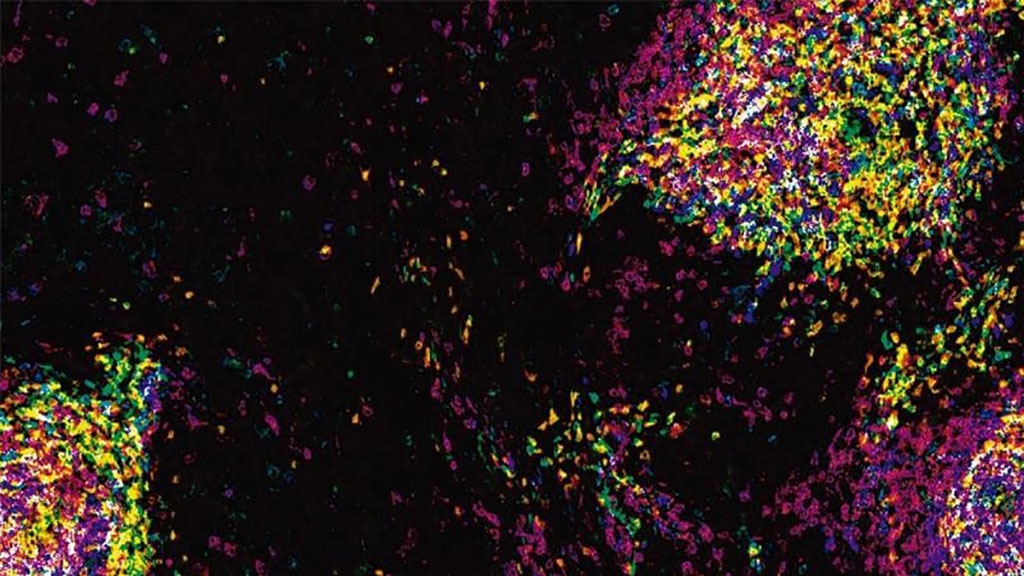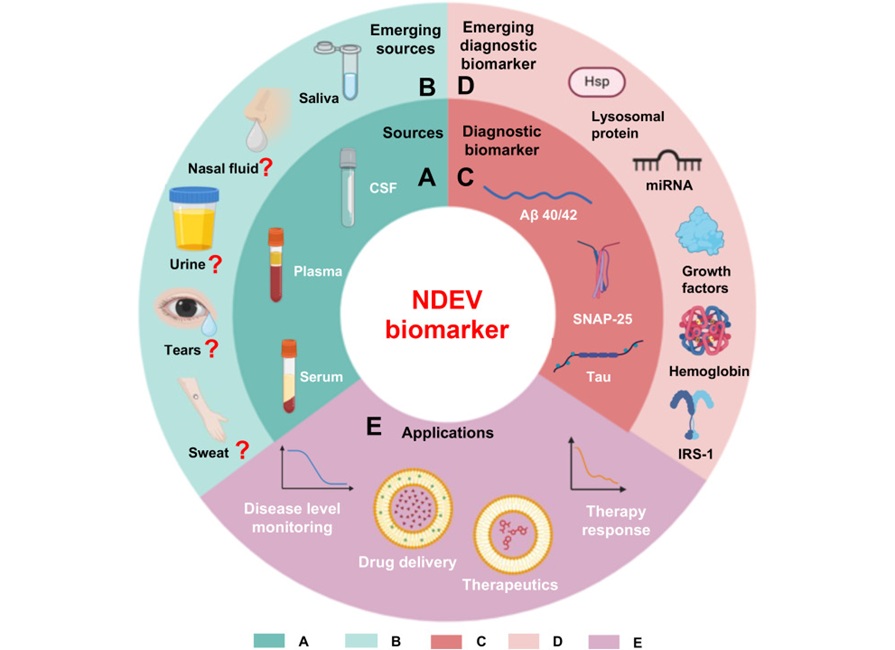Immune Cells Hampered Fighting Soft Tissue and Bone Sarcomas
|
By LabMedica International staff writers Posted on 06 Jul 2020 |

Image: Aggregates of immune cells known as tertiary lymphoid structures (TLSs), seen here within a tumor of the soft tissues known as a rhabdomyosarcoma, are major players in the immune system’s fight against cancer (Photo courtesy of Johns Hopkins Kimmel Cancer Center).
Immunotherapies such as checkpoint inhibitors that enhance the body's natural ability to fight cancer have been only minimally successful in treating sarcomas which are rare cancers that grow in the soft tissues and bones.
There are many subtypes of sarcoma, which are classified based on the specific tissue and type of cell from which the tumor originates. Sarcomas are primary connective tissue tumors, meaning that they arise in connective tissues. This is in contrast to secondary (or "metastatic") connective tissue tumors, which occur when a cancer from elsewhere in the body (such as the lungs, breast tissue or prostate) spreads to the connective tissue.
Oncologists at the Johns Hopkins Kimmel Cancer Center (Baltimore, MD, USA) and their numerous colleagues interrogated the tumor microenvironment (TME) of two contrasting soft-tissue sarcomas (STS), rhabdomyosarcomas and undifferentiated pleomorphic sarcomas (UPS), with differing genetic underpinnings and responses to immune checkpoint inhibition to understand the mechanisms that lead to response. The team used fresh and formalin-fixed, paraffin-embedded tissue from patients diagnosed with UPS and rhabdomyosarcomas, and dissected the TME by using immunohistochemistry (IHC), flow cytometry, and comparative transcriptomic studies.
The investigators discovered that both tumor types were ripe with tumor-associated macrophages (TAMs). Heavily involved in promoting tumor initiation and growth, TAMs hamper the proper immune reaction against tumors. Additionally, both sarcomas had similar amounts of CD8+ T lymphocytes (CD 8+ T cells are also known as "killer T cells"), immune system cells that protect the body from infection and are believed to be among the front-line soldiers in the fight against cancers. They also discovered that where the CD8+ T cells congregated and how their antitumor functions were impeded by TAMs differed in the two sarcomas.
In UPS, the group found that the tumors themselves were filled with TAMs and CD8+ T cells. With constant stimulation by tumor antigens, CD8+ cells produce large amounts of PD-1, a protein that eventually exhausts the T cell population. When this happens, the authors suggest, and TAMs control the environment, normal T cell activity against the cancer is suppressed. In rhabdomyosarcomas, they found CD8+ T cells only within tiny aggregates of immune cells called tertiary lymphoid structures (TLSs). TLSs are known to play a major role in initiating antitumor immune responses, helping the immune system recognize cancer cells as targets.
Nicolas Llosa, MD, an assistant professor of oncology and senior author of the study said, “The basis of successful immunotherapy lies in the ability of the immune system to recognize cancer as foreign and attack, and is dependent on genetics, host and environmental factors, and makeup of the tumor microenvironment. We need to understand the immune niche that sustains these tumors and how it supports tolerance, so we can determine what drug targets could be used to help mount a better response.”
The authors concluded that their work in soft tissue sarcomas revealed an immunosuppressive TME dominated by myeloid cells, which may be overcome with activation of T cells that traffic into the tumor. In rhabdomyosarcomas, targeting T cells found within TLS may be crucial to achieve antitumor response. The study was published on June 16, 2020 in the journal Clinical Cancer Research.
Related Links:
Johns Hopkins Kimmel Cancer Center
There are many subtypes of sarcoma, which are classified based on the specific tissue and type of cell from which the tumor originates. Sarcomas are primary connective tissue tumors, meaning that they arise in connective tissues. This is in contrast to secondary (or "metastatic") connective tissue tumors, which occur when a cancer from elsewhere in the body (such as the lungs, breast tissue or prostate) spreads to the connective tissue.
Oncologists at the Johns Hopkins Kimmel Cancer Center (Baltimore, MD, USA) and their numerous colleagues interrogated the tumor microenvironment (TME) of two contrasting soft-tissue sarcomas (STS), rhabdomyosarcomas and undifferentiated pleomorphic sarcomas (UPS), with differing genetic underpinnings and responses to immune checkpoint inhibition to understand the mechanisms that lead to response. The team used fresh and formalin-fixed, paraffin-embedded tissue from patients diagnosed with UPS and rhabdomyosarcomas, and dissected the TME by using immunohistochemistry (IHC), flow cytometry, and comparative transcriptomic studies.
The investigators discovered that both tumor types were ripe with tumor-associated macrophages (TAMs). Heavily involved in promoting tumor initiation and growth, TAMs hamper the proper immune reaction against tumors. Additionally, both sarcomas had similar amounts of CD8+ T lymphocytes (CD 8+ T cells are also known as "killer T cells"), immune system cells that protect the body from infection and are believed to be among the front-line soldiers in the fight against cancers. They also discovered that where the CD8+ T cells congregated and how their antitumor functions were impeded by TAMs differed in the two sarcomas.
In UPS, the group found that the tumors themselves were filled with TAMs and CD8+ T cells. With constant stimulation by tumor antigens, CD8+ cells produce large amounts of PD-1, a protein that eventually exhausts the T cell population. When this happens, the authors suggest, and TAMs control the environment, normal T cell activity against the cancer is suppressed. In rhabdomyosarcomas, they found CD8+ T cells only within tiny aggregates of immune cells called tertiary lymphoid structures (TLSs). TLSs are known to play a major role in initiating antitumor immune responses, helping the immune system recognize cancer cells as targets.
Nicolas Llosa, MD, an assistant professor of oncology and senior author of the study said, “The basis of successful immunotherapy lies in the ability of the immune system to recognize cancer as foreign and attack, and is dependent on genetics, host and environmental factors, and makeup of the tumor microenvironment. We need to understand the immune niche that sustains these tumors and how it supports tolerance, so we can determine what drug targets could be used to help mount a better response.”
The authors concluded that their work in soft tissue sarcomas revealed an immunosuppressive TME dominated by myeloid cells, which may be overcome with activation of T cells that traffic into the tumor. In rhabdomyosarcomas, targeting T cells found within TLS may be crucial to achieve antitumor response. The study was published on June 16, 2020 in the journal Clinical Cancer Research.
Related Links:
Johns Hopkins Kimmel Cancer Center
Latest Immunology News
- Ultrasensitive Liquid Biopsy Demonstrates Efficacy in Predicting Immunotherapy Response
- Blood Test Could Identify Colon Cancer Patients to Benefit from NSAIDs
- Blood Test Could Detect Adverse Immunotherapy Effects
- Routine Blood Test Can Predict Who Benefits Most from CAR T-Cell Therapy
- New Test Distinguishes Vaccine-Induced False Positives from Active HIV Infection
- Gene Signature Test Predicts Response to Key Breast Cancer Treatment
- Chip Captures Cancer Cells from Blood to Help Select Right Breast Cancer Treatment
- Blood-Based Liquid Biopsy Model Analyzes Immunotherapy Effectiveness
- Signature Genes Predict T-Cell Expansion in Cancer Immunotherapy
- Molecular Microscope Diagnostic System Assesses Lung Transplant Rejection
- Blood Test Tracks Treatment Resistance in High-Grade Serous Ovarian Cancer
- Luminescent Probe Measures Immune Cell Activity in Real Time
- Blood-Based Immune Cell Signatures Could Guide Treatment Decisions for Critically Ill Patients
- Novel Tool Predicts Most Effective Multiple Sclerosis Medication for Patients
- Companion Diagnostic Test for CRC Patients Identifies Eligible Treatment Population
- Novel Tool Uses Deep Learning for Precision Cancer Therapy
Channels
Clinical Chemistry
view channel
Compact Raman Imaging System Detects Subtle Tumor Signals
Accurate cancer diagnosis often depends on labor-intensive tissue staining and expert pathological review, which can delay results and limit access to rapid screening. These conventional methods also make... Read more
Noninvasive Blood-Glucose Monitoring to Replace Finger Pricks for Diabetics
People with diabetes often need to measure their blood glucose multiple times a day, most commonly through finger-prick blood tests or implanted sensors. These methods can be painful, inconvenient, and... Read moreMolecular Diagnostics
view channel
Neuron-Derived Extracellular Vesicles Could Improve Alzheimer’s Diagnosis
Alzheimer’s disease is becoming increasingly common as global populations age, yet effective treatments for advanced stages remain limited. Early detection is therefore critical, but current diagnostic... Read more
Sample Prep Instrument to Empower Decentralized PCR Testing for Tuberculosis
Tuberculosis remains the deadliest infectious disease worldwide despite being both treatable and curable when diagnosed early. A major barrier to timely diagnosis is that PCR-based TB testing is still... Read more
Endometriosis Blood Test Could Replace Invasive Laparoscopic Diagnosis
Endometriosis affects an estimated 1 in 10 women globally, yet diagnosis can take 7 to 10 years on average due to the invasive nature of laparoscopy and lack of accurate, non-invasive tests.... Read more
World's First NGS-Based Diagnostic Platform Fully Automates Sample-To-Result Process Within Single Device
Rapid point-of-need diagnostics are of critical need, especially in the areas of infectious disease and cancer testing and monitoring. Now, a direct-from-specimen platform that performs genomic analysis... Read moreHematology
view channel
MRD Tests Could Predict Survival in Leukemia Patients
Acute myeloid leukemia is an aggressive blood cancer that disrupts normal blood cell production and often relapses even after intensive treatment. Clinicians currently lack early, reliable markers to predict... Read more
Platelet Activity Blood Test in Middle Age Could Identify Early Alzheimer’s Risk
Early detection of Alzheimer’s disease remains one of the biggest unmet needs in neurology, particularly because the biological changes underlying the disorder begin decades before memory symptoms appear.... Read more
Microvesicles Measurement Could Detect Vascular Injury in Sickle Cell Disease Patients
Assessing disease severity in sickle cell disease (SCD) remains challenging, especially when trying to predict hemolysis, vascular injury, and risk of complications such as vaso-occlusive crises.... Read more
ADLM’s New Coagulation Testing Guidance to Improve Care for Patients on Blood Thinners
Direct oral anticoagulants (DOACs) are one of the most common types of blood thinners. Patients take them to prevent a host of complications that could arise from blood clotting, including stroke, deep... Read moreMicrobiology
view channel
New UTI Diagnosis Method Delivers Antibiotic Resistance Results 24 Hours Earlier
Urinary tract infections affect around 152 million people every year, making them one of the most common bacterial infections worldwide. In routine medical practice, diagnosis often relies on rapid urine... Read more
Breakthroughs in Microbial Analysis to Enhance Disease Prediction
Microorganisms shape human health, ecosystems, and the planet’s climate, yet identifying them and understanding how they are related remains a major scientific challenge. Even with modern DNA sequencing,... Read morePathology
view channel
AI Tool Simultaneously Identifies Genetic Mutations and Disease Type
Interpreting genetic test results remains a major challenge in modern medicine, particularly for rare and complex diseases. While existing tools can indicate whether a genetic mutation is harmful, they... Read more
Rapid Low-Cost Tests Can Prevent Child Deaths from Contaminated Medicinal Syrups
Medicinal syrups contaminated with toxic chemicals have caused the deaths of hundreds of children worldwide, exposing a critical gap in how these products are tested before reaching patients.... Read more
Tumor Signals in Saliva and Blood Enable Non-Invasive Monitoring of Head and Neck Cancer
Head and neck cancers are among the most aggressive malignancies worldwide, with nearly 900,000 new cases diagnosed each year. Monitoring these cancers for recurrence or relapse typically relies on tissue... Read moreTechnology
view channel
AI Predicts Colorectal Cancer Survival Using Clinical and Molecular Features
Colorectal cancer is one of the most common and deadly cancers worldwide, and accurately predicting patient survival remains a major clinical challenge. Traditional prognostic tools often rely on either... Read more
Diagnostic Chip Monitors Chemotherapy Effectiveness for Brain Cancer
Glioblastoma is one of the most aggressive and fatal brain cancers, with most patients surviving less than two years after diagnosis. Treatment is particularly challenging because the tumor infiltrates... Read moreIndustry
view channel
BD and Penn Institute Collaborate to Advance Immunotherapy through Flow Cytometry
BD (Becton, Dickinson and Company, Franklin Lakes, NJ, USA) has entered into a strategic collaboration with the Institute for Immunology and Immune Health (I3H, Philadelphia, PA, USA) at the University... Read more




 assay.jpg)














